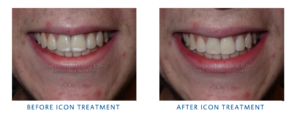Written by Dr. Jeanette MacLean | March 2019
Unsightly congenital enamel defects can be a source of embarrassment for many patients. Some become disappointed when their attempts to camouflage the lesions by tooth whitening end up making the spots even more noticeable. Historically, these blemishes have been treated with invasive and costly resin bondings and veneers. Icon Resin Infiltration (DMG) represents a revolutionary treatment approach to managing these lesions in one quick, simple, and painless appointment.
Originally developed to treat incipient carious lesions, it was later discovered that the same technology utilized by Icon to infiltrate enamel porosities caused by acids could also reverse congenital enamel lesions. Regardless of the causative factor – be it molar incisor hypomineralization, fluorosis, a history of trauma or infection of the primary tooth, illness in infancy, gestation associated with high fever and/or antibiotics, or unknown etiology – Icon can help. This approach is particularly appealing for young children who are sometimes the target of teasing, since it can be performed at a young age and will not reduce bond strength to orthodontic brackets if needed in the future. Other advantages include the absence of shots and drilling, conservation of natural tooth structure, and stable results after whitening.
Procedure Overview
Using Smooth Surface Treatment Set (DMG), Icon-Etch (15% hydrochloric acid) is applied to the tooth surface for 2 minutes, twice, followed by Icon-Dry (ethanol). Etching may be repeated, as needed, to achieve desired results. Results for stubborn spots may be enhanced by additional rounds of Icon-Etch and/or gently polishing the surface of the tooth. The tooth is then flooded with a highly fluid resin, Icon-Infiltrant, which penetrates deeply into the enamel microporosities via capillary action. After being absorbed for 3 minutes, excess Icon-Infiltrant is removed and the tooth is light cured. The Icon-Infiltrant is applied again for 1 minute and, after the excess is removed, light cured and then finished with polishing disks. The refractive index of Icon-Infiltrant mimics the surrounding enamel, creating the optical illusion of healthy enamel with uniform color and long-lasting results.
Case Study
An 18-year-old male was self-conscious about the congenital enamel defects on his maxillary central incisors. He tried at-home whitening, which only made the white spots more noticeable. After considering resin bondings or porcelain veneers, Icon Resin Infiltration was presented as a minimally invasive treatment option. The simple, affordable, painless, and conservative nature of this treatment option appealed to both the patient and his mother. His case required only a single, 30-minute appointment that included three rounds of the Icon-Etch to achieve the desired results. The patient was ecstatic with the outcome of Icon Resin Infiltration and his results have been stable for 5 years and counting.

About the Author
Dr. Jeanette MacLean is a Diplomate of the American Board of Pediatric Dentistry, a Fellow of the American Academy of Pediatric Dentistry, and a pediatric private practice owner in Glendale, Arizona. She is an advocate of minimally invasive dentistry. Her website (www.kidsteethandbraces.com) contains more information on this topic, as well as comprehensive, evidence-based continuing education courses.
